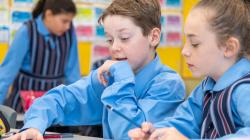This is a classic reSolve sequence aligned with the Australian Curriculum V8.4. It is only available as a downloadable package.
Explore our new sequences for Year 5 aligned to AC V9
This sequence gives students a range of strategies for multidigit multiplication, highlighting strategies based on the distributive property and the associative property. The lessons develop the array as a tool for multiplication. Students move in a careful developmental sequence from an array with all items perceived, to a grid array, then on to an open array and area model for multiplication.
These lessons are designed for students with prior knowledge of multiplication. The focus on understanding multiplication and its properties through arrays is intended both to support learning of new multiplication skills and to deepen students’ appreciation of rules that they have learned.
Lesson 1: How Many Cupcakes?
Students calculate the number of cupcakes baked each day in a bakery. The cupcakes are cooked in 6 × 4 trays. Students solve the problem using their own strategies and illustrate the strategies using the array. As strategies are shared, students reflect on the efficiency and ease of strategies, as well as their suitability for the context.
Lesson 2: The Cupcake Order
This lesson generalises repeated doubling strategies. Students find the number of cupcakes in 40 trays by multiplying by the factors of 40. This is a practical use of the associative property.
Lesson 3: Cupcake Boxes
This lesson uses arrays to build an understanding of the distributive property and the way in which it relates to the multiplication of two-digit numbers. During an investigation comparing the areas of boxes for cupcakes, students observe the convenience of partitioning the array into tens and units, then using the distributive property to multiply. Students use open arrays and an area model for multiplication, and engage with equal group and rate problems.
Last updated June 20 2020.
This is a classic reSolve sequence aligned with the Australian Curriculum V8.4. It is only available as a downloadable package.
Teacher tools
Our new all-online sequence Multiplication: Trays of Arrays adapts and extends the ideas in this sequence. Multiplication: Trays of Arrays is aligned to the Australian Curriculum V9 and contains embedded professional learning and supplementary teacher advice.
Multiplication: Trays of arrays
Students learn to use the properties of multiplication to solve multiplication problems which are represented as an array.

